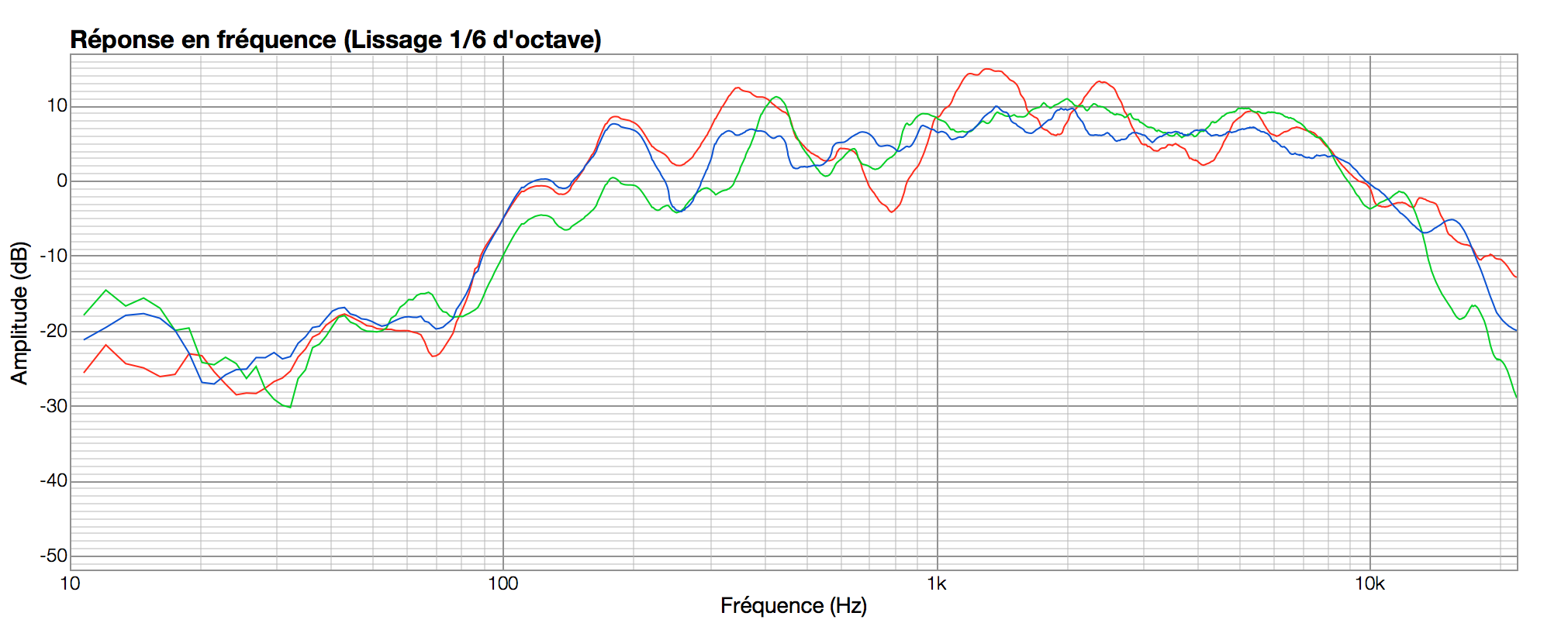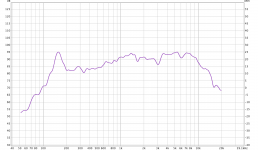BTW, have you ever heard 400,000 theory?
I ideal speaker's low cut and high cut frequency should be; LF x HF = 400,000.
If the low cut is 100Hz, your desirable high cut is 4000Hz. (100x4000=400,000).
This is my favorite voodoo theory. 🙂
Have actually not heard about it, but actually does not sound too much off grid for what I am looking for.
What do you mean with 'great transient response'? Critical damping (Q=0.5) at the lower cutoff? A lack of membrane resonances? A quickly decaying impulse response which means having no bass?
I mean "optimale Transientenwiedergabe ohne Nachschwingen der Membran", explained on page 22 of the following presentation:
https://engineering.purdue.edu/ece103/LectureNotes/SRS_Loudspeaker_Parameters.pdf
So I guess total Q of 0.5 would be the aim, if I am not missing something.
Dear SP,
Regardless of the fact that this is not a full range design, it is not a mult-way speaker.
I directed you to a thread with an excellent driver:
1. It fits within your budget.
2. Has excellent midrange performance
3. Can be run crossover-less
Gets some free box modeling software, put in the driver's Thiele Small parameters from its data sheet.
Start adjusting the box volume in the software for a sealed enclosure. See if it gives you the low frequency extension you need.
Come back here and we will help you.
This is a DIY forum, therefore, I encourage you to learn and research your project.
Cheers,
Greg
Thanks for your suggestion mate, but I know the Karlsonator and it is not what I asked for.This thread is part of my research, sharing knowledge and ideas with likeminded people, everybody is welcome to join or not, everybody decides on his/her own.
Speakerdesign is, as you know, about managing trade offs. I know a bit about it, but may easily overlook something, therefore the thread.
Simply the most useful mix tool I've ever come across.
My 80s vintage ones are going to be buried with me.
100% agree.
I am already doing most of my work on a clone I designed myself with a cheap mid range driver, but I now want to max it out a bit by ooptimising the driver choice and, if necessary, also the enclosure.
Simply the most useful mix tool I've ever come across.
My 80s vintage ones are going to be buried with me.
I really liked the sound of 5C while I have never used it for mixing. I should have bought them when they were $30.
I still trust my secret boombox and NS10M. 🙂
I think you need to define what you want from the high end of the driver, rolling off low is easy, low Qt is easy, but not usual in drivers that have an extended high end
Low Qt just makes it easy to have a small box without any 'humping', under ~ .4 should be OK
auratone fr here:
Auratone 5C passive studio monitors reviewed - Audiofanzine
Just a thought - it might be easier to use a high Q driver open baffle.. I have a pair of 4" boombox drivers which sound excellent in a small open backed cube, with plenty of stuffing behind them
Low Qt just makes it easy to have a small box without any 'humping', under ~ .4 should be OK
auratone fr here:
Auratone 5C passive studio monitors reviewed - Audiofanzine
Just a thought - it might be easier to use a high Q driver open baffle.. I have a pair of 4" boombox drivers which sound excellent in a small open backed cube, with plenty of stuffing behind them
Last edited:
I think you need to define what you want from the high end of the driver, rolling off low is easy, low Qt is easy, but not usual in drivers that have an extended high end
Low Qt just makes it easy to have a small box without any 'humping', under ~ .4 should be OK
auratone fr here:
Auratone 5C passive studio monitors reviewed - Audiofanzine
Just a thought - it might be easier to use a high Q driver open baffle.. I have a pair of 4" boombox drivers which sound excellent in a small open backed cube, with plenty of stuffing behind them
Very good point.
The high end should be roling of somewhere between 5 and 7k, max would be 9k. A rolloff without too much peaks and spikes would be desirable.
At the end, it is not 100% important to hit the frequency perfectly, it is more important that the focus is the mid range and the upper bass.
I somehow shy away from high q because I associate with non optimum transient response, and I really want this little speaker to really show every single bit that is in the music it is being fed with (of course within the limited frequency range it provides).
But this might be due to lack of knowledge? Is a total Q of 0.5 really the best solution regarding transient response?
I really liked the sound of 5C while I have never used it for mixing. I should have bought them when they were $30.
I still trust my secret boombox and NS10M. 🙂
Only goes to show that speakers are a very personal thing!
I have never managed to get a good mix out of NS10s.
I'm sure I could but I would be fighting them all the way and would never be able to relax having to second guess them at all times. 🙂
The only thing more personal are headphones in my experience.
Here are a few drivers that might meet your needs (although the peerless might be somewhat high in Qts for you)
Silver Flute W17RC38-08
SBAcoustics SB13PFC25-08
Peerless PPB 830860
The silver flute in a 16L box has Qtc of .5 and f3 of 112 Hz.
Silver Flute W17RC38-08
SBAcoustics SB13PFC25-08
Peerless PPB 830860
The silver flute in a 16L box has Qtc of .5 and f3 of 112 Hz.
The TSPs that might point you in the right direction seem to be Mms & Qts, both as low as possible, and a linear phase plot... Alu cones? - but then you may have to deal with the breakup...
forgot, low inductance may help, so low Re?
forgot, low inductance may help, so low Re?
Last edited:
Here are a few drivers that might meet your needs (although the peerless might be somewhat high in Qts for you)
Silver Flute W17RC38-08
SBAcoustics SB13PFC25-08
Peerless PPB 830860
The silver flute in a 16L box has Qtc of .5 and f3 of 112 Hz.
Thanks, that looks interesting.
I just found a frequency response curve of the original auratones, giving an indication in which direction the rolloff in the highs and lows should go and how the mid scoop might look like.

The TSPs that might point you in the right direction seem to be Mms & Qts, both as low as possible, and a linear phase plot... Alu cones? - but then you may have to deal with the breakup...
forgot, low inductance may help, so low Re?
Yes, sounds right. I am tending towards paper cones, if I have to choose the material.
A completely linear frequency response is not necessary, but what should be avoided is rising levels with rising frequency or heavy fluctuations at the breakup point....in the example I posted earlier, the focus is on the 2khz region, afterwards it starts gently to fall and before 2khz it does the same. I try to replicate this.
This is my naked (no baffle) vintage field coil's response (w/EQ for my taste). It's interesting to see it's not much different from Auratone.
Auratone curve can be a good reference, I think.
That actually looks very interesting. The dips around 2k do not look that good, but the overall impression looks quite similar indeed.
That actually looks very interesting. The dips around 2k do not look that good, but the overall impression looks quite similar indeed.
hahaha, I think it was my intention (BBC dip). 😀
I have never managed to get a good mix out of NS10s.
Yeah, I know more ns10 haters than ns10 lovers. 🙂
Bryston amp was popular to drive those in US, and it certainly makes a big difference. What is a popular amp to drive ns10 in England?
Well, I'm listening to this field coil speaker now (mounted on microphone stand).
I forgot to say something about it. If you really want a good transient, people say nothing better than field coil because its magnetic field is very tough, and I would agree with it (I'm listening to it now). Very fast for non compression driver. You can buy Voxativ or Feastrex field coil for $$$$$$$$, but you can still find a nice German vintage field coil on Ebay for a reasonable price if you're in Europe. I would recommend to consider this option. You may think current modern driver is better, but I do not believe that story especially when flat FR is not the first priority.
I forgot to say something about it. If you really want a good transient, people say nothing better than field coil because its magnetic field is very tough, and I would agree with it (I'm listening to it now). Very fast for non compression driver. You can buy Voxativ or Feastrex field coil for $$$$$$$$, but you can still find a nice German vintage field coil on Ebay for a reasonable price if you're in Europe. I would recommend to consider this option. You may think current modern driver is better, but I do not believe that story especially when flat FR is not the first priority.
I've had [ and blown up] a couple of pairs of Auratone 5Cs.
As something to replicate the sound you could get from a portable transistor radio they were pretty good.
But the old standby and my favourite easy to use midrange is the Vifa P-13 and in a small stuffed cube would equal and better the Aurotone
As something to replicate the sound you could get from a portable transistor radio they were pretty good.
But the old standby and my favourite easy to use midrange is the Vifa P-13 and in a small stuffed cube would equal and better the Aurotone
- Status
- Not open for further replies.
- Home
- Loudspeakers
- Full Range
- Help me design this midrange only speaker
